After the Spring, there is always a Winter. It is the cyclical nature of the business to thrive in a boom period, experience harsh times, and be reborn under new stars. After the success of the Three Musketeers era in the 90s, New Japan Pro Wrestling had fallen to the depths of creative and financial bankruptcy in the early 2000s. But like any great pro wrestler, their fighting spirit would not quit. In order to survive, they changed the status quo and paved the way for the next generation: Hiroshi Tanahashi. Shinsuke Nakamura. Wrestle Kingdom. After the Winter, there is always a Spring.
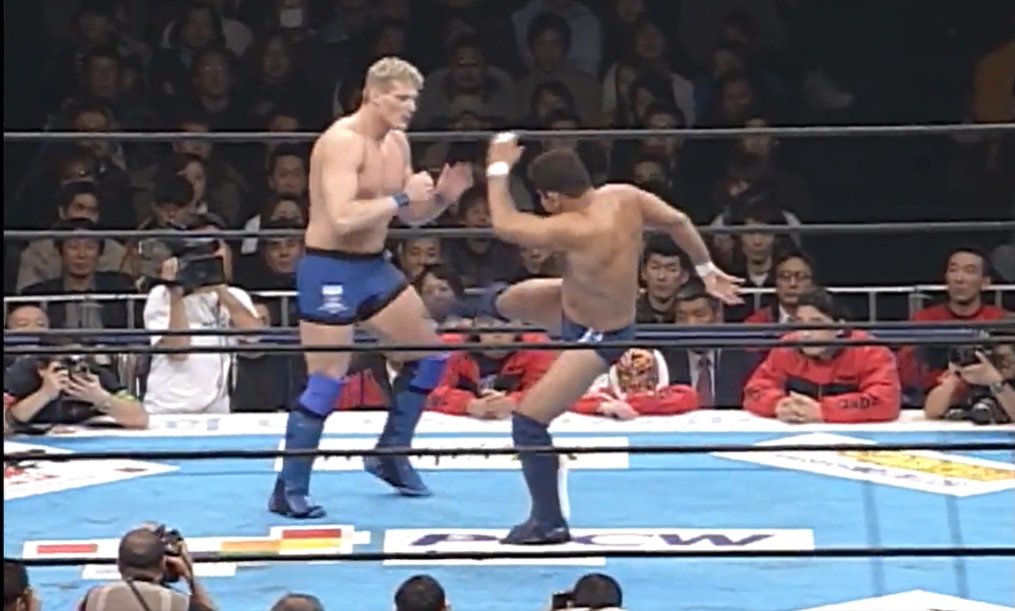
Wrestle Kingdom
January 4 at the Tokyo Dome
For as gargantuan a presence NJPW has had in the 21st century, where industry leaders WWE and AEW reference their product in major storylines, it’s shocking to consider how low they were some 20 years ago. On January 4th, 1999, the same date when the Fingerpoke of Doom and Mankind putting butts in seats went down in the history books, NJPW had a major controversy of their own.
It was at the 8th annual Tokyo Dome show before they were even called Wrestle Kingdom when judo champion Naoya Ogawa shot on Shinya Hashimoto during their bout and bloodied him up. Dave Meltzer wrote in the Wrestling Observer Newsletter at the time that “there are some who believe Hashimoto’s tough-guy gimmick was destroyed and he’ll need to be repackaged.”
The times were indeed changing. As MMA got big in Japan, pro wrestling grew small. Giant Baba, one of the godfathers of the sport, had died in 1999. Mitsuhara Misawa had led the exodus out of All Japan to form NOAH. And Antonio Inoki became obsessed with the idea of pitting his New Japan pro wrestlers against shootfighters.
Inoki booked MMA guys to be IWGP champion. He booked his own guys in shoot fights. MMA fighter Josh Barnett had his first-ever match in the main event of the Tokyo Dome. The generation after the 90s Musketeers were being squandered as Yuji Nagata was getting beat up trying to carry the company, and Satoshi Kojima had left for AJPW with his mentor Keiji Mutoh.
The downfall was, of course, reflected in their finances. Attendance was down. Revenue was down. In 2005, the company was on the verge of bankruptcy with Bryan Alvarez writing in a November issue of Figure Four Weekly that “there were very strong rumors that New Japan wasn’t going to last the year.”
Inoki sold his majority shares to Yuke’s, the video game developer behind some NJPW titles in the 90s and the hit WWE video games of the early 2000s. Almost like how when Marvel was on the brink of death and was bought out by the company that made their toys. That’s how big the mighty had fallen. Under new management, NJPW would enter 2006 with an utter mess on their hands.
Wrestle Kingdom 1
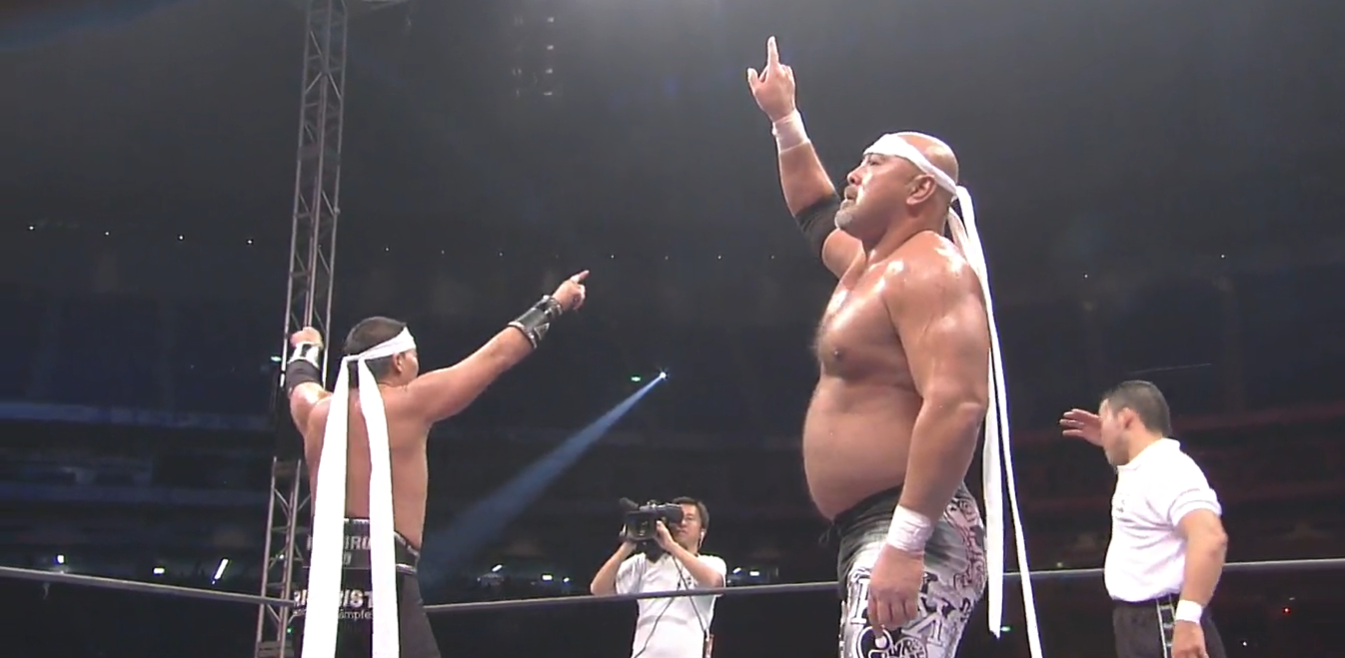
The Tokyo Dome show on January 4, 2006, was thought to be the last one they ever do. Brock Lesnar squashed Shinsuke Nakamura in the main event to retain the IWGP title. Also on the card, Hiroshi Tanahashi lost to Katsuyori Shibata, who had left NJPW the previous year to go freelance. Bryan Alvarez described it in F4W as “further proving my theory that New Japan has no idea what to do with Tanahashi, hence his trip to TNA in America.”
With the Third Generation of the New Japan Dojo (Nagata, Kojima, Tenzan) passed over, it was up to the New Three Musketeers to step up to the plate. Shibata aside, Nakamura and Tanahashi were progressing at a quick pace. The two even main evented the Dome in 2005 for the Under-30 championship.
By the way, on the undercard of that 2005 show is a bizarre Ultimate Royal match where two separate “worked shoot” fights with separate referees were happening in the ring at the same time, and it was also an 8-man tournament. At that moment, Meltzer in the WON pronounced the January 4th tradition “dead and buried.”
Nakamura had been dubbed Super Rookie and won the IWGP title in his second year. And, of course, there’s the famous Scott Hall story that he put over a young Tanahashi in 2001 because he saw the potential within him. He wasn’t the only one, as in the summer of 2006, when Lesnar left the company, IWGP belt in hand, Tanahashi filled the vacancy when he won his first world championship in beating the big ugly gaijin, Giant Bernard.
Wrestle Kingdom 1 on January 4, 2007, pitted New Japan vs. All Japan. With respect to Bull Buchanan, D’Lo Brown, and Travis Tomko losing to Togi Makabe, Toru Yano, and Tomohiro Ishii with hair, the top 4 matches are the key to the card. Shinsuke Nakamura faced off against the legendary Toshiaki Kawada.
While Nakamura had the support of the crowd, Kawada punished him with strikes and submissions. The young supernova had his moments, including german suplexing Kawada onto his neck who then simply stood up shaking his head. Nakamura kicked out of a lot, but ultimately lost.
Meanwhile, in the penultimate match, Hiroshi Tanahashi successfully defended the IWGP title from Taiyo Kea. It was an exciting bout with Kea’s flashy martial arts, but Tanahashi’s speed and agility prevailed. Also at the Dome, Minoru Suzuki successfully defended the All Japan Triple Crown against Yuji Nagata. And in the special reunion main event, Keiji Mutoh and Masahiro Chono defeated Tenzan and Kojima in tribute to their fellow Musketeer Shinya Hashimoto, who passed away in 2005, to close out the first Wrestle Kingdom.
Wrestle Kingdom 2

One year later, the 2008 Tokyo Dome show was still being thought of as a money-losing endeavor with an inflated attendance number. Wrestle Kingdom 2 was a collaboration with TNA. While Impact had national US television and served as the excursion partner for young talent, they were on the creative decline somewhere between 2005 TNA and 2010 TNA. Nevertheless, some late-night exposure can’t be bad, especially in an era when WWE was referring to Tanahashi as a fan in a picture with Jeff Hardy.
Hirooki Goto, a newcomer to the heavyweight division, went up against the Great Muta in a losing effort to the outsider. Perhaps this is the first case of the Goto-always-loses allegations. In the semi-main, Nagata lost to Kurt Angle in a battle for physical possession of the IWGP belt that Lesnar stole.
And in the main event of Wrestle Kingdom 2, Nakamura challenged Tanahashi for the new IWGP title. It was a spirited bout between two able-bodied athletes capable of exciting, high-impact moves at just under and over 30 years old, respectively. Tanahashi played the heel role in the match, taking some cheap shots in the ropes and working over Nakamura’s taped shoulder.
The design was to get the rub from the Ace and make a secondary star in the eyes of the crowd. And the plan appeared to work, as Tanahashi passed the shine onto his fellow Musketeer while Nakamura would later go on to defeat Kurt Angle and reunify the broken lineages of the IWGP titles into the beautiful 4th version of the modern era.
Wrestle Kingdom 3
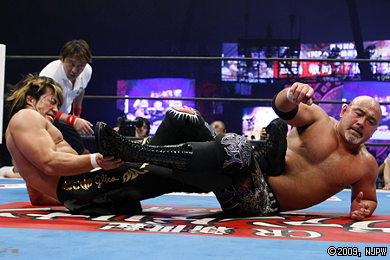
January 4, 2009: the horizon began to brighten for New Japan. Their previous financial quarter was reportedly their first to turn a profit in some years. At Wrestle Kingdom 3, Nagata finally beat an outsider in Zero1’s Masato Tanaka. And in the semi-main, Nakamura and Goto defeated the visiting team of Mitsuhara Misawa and Takashi Suguira in a highly anticipated match against the NOAH stars who dominated the early 2000s Japanese scene.
The main event was built around Keiji Mutoh, who had won the IWGP title from Nakamura and defended it from various New Japan stars. Meanwhile, unsatisfied with winning only his first and last of 6 matches in the G1 Climax, after winning the tournament the previous year, Tanahashi spent a couple weeks working TNA in the fall.
As the story goes, NJPW President Naoki Sugabayashi came to Orlando himself to bring Tanahashi back to save the belt. And in a long, somewhat plodding match against the veteran, Tanahashi won to become the 50th IWGP Heavyweight Champion. The old guard was defeated. For now.
The Wrestling Observer recognized several signs of a comeback from Wrestle Kingdom 3. Attendance was up for the third straight year. A generation of 20 somethings seemed to have become fans. One report noted that the young audience didn’t react much to the theme songs of legends Riki Choshu and Misawa. Meltzer suggested that these were newer fans who weren’t around for the glory days and thus watched wrestling simply because it was cool.
Wrestle Kingdom 4
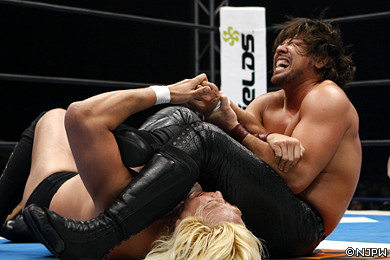
The theme of the 2010’s Wrestle Kingdom 4 was NJPW vs. NOAH. Also, on January 4 was TNA’s ill-advised move to Monday night to compete with WWE. But instead of trotting out the old stars in the spotlight, in Japan, the current wave was allowed to take center stage. Misawa had passed away. The Four Pillars and the Three Musketeers were getting too old and too hurt to main event. And the new generation of fans once more gathered for a solid attendance figure.
Young talent like Kazuchika Okada and Tetsuya Naito were beginning to show up on the undercards. Nagata lost to outsiders again. Legends like Terry Funk and Abdullah the Butcher were kept in a mid-card 8-man. In a battle of the Aces, Tanahashi went up against Go Shiozaki, NOAH’s successor to Misawa and Kobashi. The match had the crowd going wild for these flashy, exciting moves, with Tanahashi picking up the victory.
In the main event of Wrestle Kingdom 4, Nakamura defended the IWGP title against Yoshihiro Takayama. The match featured plenty of clubbing blows and punishment for the champion. Meltzer noted in the Observer that the people hadn’t quite accepted Nakamura at the top, and this win was to add credibility.
It was more of an MMA-style match of years past, slow and steady, as opposed to the Tanahashi match. Even though he had since lost the MMA attire over the years and adopted the tight black pants, Nakamura was still not yet the god of charisma he would soon become.
Wrestle Kingdom 5
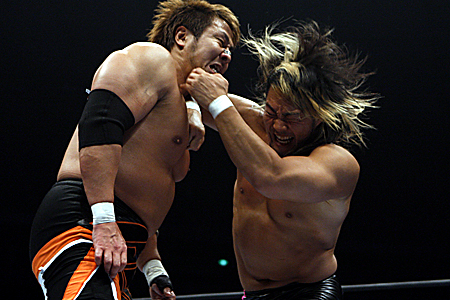
January 4, 2011, marked the end of one era and the beginning of the next. NJPW announced their first U.S. tour at Wrestle Kingdom 5. And unbeknownst to them at the time, this would be their last Tokyo Dome in cooperation with IMPACT as the relationship would sour by the end of the year due to a certain gimmick. Enjoy Rob Van Dam over Toru Yano and Jeff Hardy over Tetsuya Naito for the TNA world title while it lasts.
Nakamura entered his marquee match against Go Shiozaki with vibrant red accessories more akin to his well-known look. All that was missing was the hairstyle. Something seemed to have evolved in Nakamura; whereas last year’s match felt like two fighters trying to score the knockout, this year’s match was pro-wrestling. Every time Go Shiozaki worked over the knee, Nakamura screamed in agony toward the back of the room.
And the crowd sounded all the more invested in it. In the Takayama match, Nakamura felt like he had to take all that punishment with a clenched jaw to show the toughness of someone who won the title when he was a 23-year-old kid and still had to prove himself. The match with Shiozaki was loud and exciting, almost a Tanahashi-in-peril style match. Nakamura won with the Bomaye, and there is no scientific way to disprove that he put a little more swag in it than last year.
With a card featuring Hiroyoshi Tenzan getting a big win after being out for over a year and Nagata defeating Suzuki, it was only fitting that the Third Generation be reunited at the Tokyo Dome. Satoshi Kojima had won the previous G1, beating Tanahashi in the finals and the IWGP title soon after as a freelancer.
Now the Once in a Century Ace sought redemption against Mutoh’s protege. The match had a big main event feel as the crowd lost their mind for every haymaker late in the match. Tanahashi reclaimed the world championship and celebrated with the fans, sending them home happy with one final “I Love You!” to end Wrestle Kingdom 5.
Epilogue

Over the first 5 years of Wrestle Kingdom, NJPW saved itself from bankruptcy. Top stars from All Japan and Noah were conquered, and two homegrown stars were forged. Shinsuke Nakamura evolved his wrestling from Inoki’s strong style into a modern-era charisma. Hiroshi Tanahashi became the once-in-a-century talent that people wanted to see. The superhero you could always count on. The Ace doesn’t lose at Wrestle Kingdom.
As the 2011 Tokyo Dome did not do a great number, President Sugabayashi considered changing the venue or the date. Yet they continued forward to a future where the Wrestle Kingdom name grew and grew into a synonym for excellence. Entering the US market. Creating their Intercontinental title. And by this time next year, a young wrestler named Kazuchika Okada would return from excursion and usher in the golden era of NJPW.










